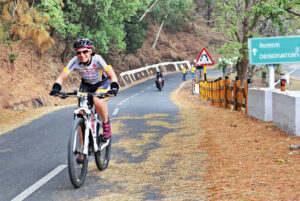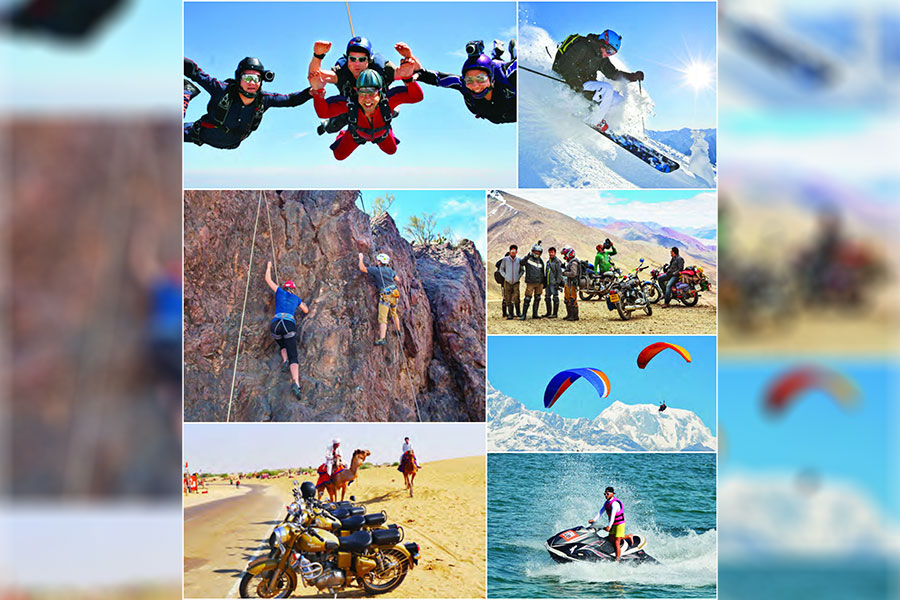Tourism August 18, 2022

For many years now, the Union Ministry of Tourism has been trying to promote India as an adventure tourism destination. While India does offer a vast range of adventure tourism activities across the entire nation, a lack of adequate infrastructure and connectivity continues to hamper the growth of this industry
There is hardly any adventure activity that you cannot enjoy in India. Be it hiking in the hills or reaching the snow-capped peaks by a breathtaking trek, from skiing, whitewater rafting and scuba diving to paragliding, bungee jumping, or skydiving – you have a large variety of destinations to indulge in, each unique in its own way.
It is with this ambition to increase the attraction of India as an adventure tourism destination that the Ministry of Tourism (MoT) has taken several steps to promote the adventure tourism opportunities in the country. It had declared the year 2018 as the Year of Adventure Tourism in India. The ministry has also organised several international summits on adventure tourism in India bringing together tour operators and tourism professionals from around the world, involved in promoting adventure tourism, as well as leading bloggers and media.
A History of Adventure
For decades, indeed centuries, India has been a destination for adventure tourists. In the late 19th century, during the British colonial rule and even before that, Indian jungles with their immense wildlife, mainly tigers but also rhinos, elephants, leopard and lions, offered an unparalleled rush of adrenaline to hunters from around the world. Hunting as an adventure continued to attract tourists till it was banned soon after India’s independence in 1947.
It was also during the British rule that the mountains across the country, mainly the Himalayas, began attracting mountaineers and trekkers from across the world in an attempt to scale the world’s highest peaks. Several hill stations or mountain resorts had sprung up in various parts of India – from Shimla, Lansdowne, Almora, Mussoorie and Darjeeling in the Himalayas to Ooty and Kodaikanal in the southern Nilgiri mountains. These resorts began attracting large traffic from the plains, especially in the summer months, and it led to the development of associated tourism activities such as trekking, angling, whitewater rafting, etc.
In the decades after independence, tourism increased consistently to these sites and a few others, notably in the mountain deserts of Ladakh in Jammu & Kashmir. However, till about a couple of decades ago, little else came up in terms of adventure tourism, largely due to the lack of demand.
Be it mountain climbing amidst the hills or tekking to reach rivers or adventure sports like paragliding, bungee jumping and skydiving – Indian terrains provide an opportunity for every type of adventure enthusiast
Rising Economy Boosts Adventure Tourism
However, since the turn of the century, there has been a significant rise in adventure tourism in India, driven mainly by young Indian travellers themselves, who benefitted from the booming information technology industry that offered relatively high paying jobs to nearly two million youths. Many of these were often young couples without children, who began taking frequent breaks for short vacations within the country. Looking for tourism beyond the old and established destinations, these young people looked for different kinds of tourism, with adventure being high on their to-do list.
Driven by the rising demand from this potentially limitless market, adventure tourism destinations began emerging across the entire nation, though mainly in and around the key tourism destinations in the country. So, Goa, which had always lured tourists for its lovely beaches, saw the emergence of numerous players offering water sports of all kinds, while operators in the Andaman & Nicobar Islands developed scuba diving for the tourists to enjoy the rich coral reefs in the area. Similarly, a number of new offers emerged – bungee jumping in the Himalayas, high-altitude trekking and mountaineering, not just for the professionals but also the amateurs, motorbike tours in difficult terrain such as the Thar Desert in Rajasthan or the Himalayan desert of Ladakh as well as other Himalayan roads and the coastal roads along the Indian peninsula.
Skiing, snowboarding and other snow-related activities have also emerged as favourites for these tourists. However, despite being home to over 100 peaks with permanent snow cover on the summits, India has less than a handful of skiing destinations. Gulmarg, about 60km north-west of Srinagar, capital of Jammu & Kashmir, boasts of having one of the world’s highest gondola rides, at about 4,000m on the summit, though the first phase reaches 3,100m. Over the last two decades, Gulmarg has emerged as a big skiing destination, offering the views of some of the world’s highest mountains, K2 or Nanga Parbat, as the skiers hurtle down the long, snow covered pistes. Skiing has been attracting tourists from all over the world, especially the expert skiers, looking for challenging pistes and challenging it is at Gulmarg where the slopes drop for over 1,500m in a vertiginous fall, dragging down all but the most expert skiers.
“We are so thrilled to be here, so high up in the Himalayas, with such a beautiful view and a breathtaking landscape. Yet, the biggest attraction for us to be here are these ski slopes and not only because they are much larger and higher than anything in Europe, but also because unlike Europe or other parts of the world, the slopes here are not at all crowded,” recounts Hanneke Guntzer, a tourist from Germany, who has come to Gulmarg for the first time with her four friends and has been floored by the experience.
Adventure tourism offers have sprung up all along the Himalayan chain, passing through the northern states of Himachal Pradesh and Uttarakhand right into northeast India. The north-eastern states have emerged as great destinations for numerous adventure activities such as water sports, trekking, mountaineering, paragliding, etc.
Connectivity & Infrastructure
Yet, as in other forms of tourism, India has so far failed to capitalise on the nature’s largesse. The country hardly figures on anyone’s list as an adventure tourism destination. This is partly due to the lack of adequate awareness about the rich offer that the country has in adventure as the promotional campaigns about India tend to focus on the other well-known strengths – heritage and culture.
“When it comes to adventure tourism, India is not the first name that comes in your mind. I would say that is because very less is spoken about adventure tourism in India. Upon my visit here, I discovered Rishikesh (a city in the northern state of Uttarakhand) and got to know that it is one of the premium destinations for bungee jumping. I wish more information was available about this beforehand. India’s diversity allows it to naturally be one of the best places for adventure tourism, but I am guessing it is not tapped,” says Tatiana Sarkova, a Russian tourist from Moscow.
Tourism professionals say the government needs to be much more proactive in promoting this aspect of Incredible India. “Adventure tourism is one of the key areas that can attract a huge segment of global youth to India. Unfortunately, the government lacks foresight, expertise and innovative ideas to promote adventure tourism. Chilika Lake, for example, which is the largest lagoon in the Northern Hemisphere, is yet to introduce water sports and water activities in the state of Odisha. Taking people around into the forest and showing them a couple of tigers is not all that adventure tourism consists of,” says J K Mohanty, chairman of Swosti Hotels, a hotel chain based in the eastern Indian state of Odisha.
The development of adventure tourism in the country, however, has been hampered by lack of adequate infrastructure, which is an even greater challenge in adventure tourism as these destinations are located in remote areas, with little connectivity by air, road or rail.
“There are many problems that restrict us. To start with, lack of air connectivity is a major hurdle. Most of our natural heritage zones are located in remote areas and they do not have air connectivity. The Goods and Service Tax (GST) is the second big deterrent. The tax paid by Indian tour operators, ranging from 28 to 33 pc, is making them uncompetitive in the world, where the average rate is below 10 pc. The third major impediment comes in the form of restrictions in accessing forests as most of the adventure tourism spots are deep inside forests, which are out of bounds for tourists, while other nations use their forests in a sustainable manner,” says Sanjay Basu, an adventure tour operator.
Capturing the Opportunity
Increasingly, the state governments as well as the federal government recognise the importance of not only promoting adventure tourism but also developing the destinations and the infrastructure to get a piece of the action.
For long, the eastern state of West Bengal has been known for its colonial architecture, its capital Kolkata and the tea gardens. But West Bengal is also home to the largest family of Indian tigers – the Bengal tiger in Sunderbans, numerous wildlife parks and of course the mountains around the iconic town of Darjeeling, in north Bengal. The state is now working to drive home the message about adventure tourism opportunities in Bengal.
“The scope to develop adventure in our state is very high and we are developing the same. We have all the ingredients. We already have our tourism policy of 2014 in place and we are working on making regulations on adventure tourism. We are going to announce new policies after taking into consideration the suggestions made by the investors, stakeholders and several other organisations related to the industry,” says a senior official of tourism ministry of West Bengal.
“Fortunately, adventure tourism is being projected as an important segment of the industry in many states, especially by the non-Himalayan states like Karnataka, Kerala, Andhra Pradesh and Madhya Pradesh. There is a huge surge in skill development in these states because the main component of our industry is skilled manpower. The Adventure Tour Operators Association of India (ATOAI) has huge plans for the coming years and hopefully with the support of the government, we will achieve our milestones,” says Swadesh Kumar, member of the ATOAI.
Some states have been ahead of the game. Uttarakhand, for example, is a natural place for adventure as its terrain of less than 53,500 sqkm packs in over three dozen snow-capped Himalayan peaks, has over a dozen rivers and countless streams and some of the most beautiful valleys and jungles that have an impressive range of wildlife, including tiger, snow leopard, bear, rhinoceros, elephant, deer, etc. Uttarakhand has for long been a big draw for trekkers and mountaineers, but in the last two decades, other activities such as whitewater rafting, bungee jumping, paragliding and rappelling have emerged.
Similar is the case with Himachal Pradesh, and Sikkim in the east, both of which have similar topography as Uttarakhand. Although water sports along the coastal areas have been slow to develop, now numerous spots around the 7,500km coastline of India offer a range of activities – scuba diving, snorkelling, jet-skiing, canoeing, etc.
Safety & Certification
With the rapid growth in adventure tourism and advent of new players, the biggest challenge for the government and adventure tour operators has been to ensure that all companies offering adventure tourism activities strictly follow safety guidelines.
One of the first issues is the presence of a large number of unrecognised operators, including tour operators, offering various adventure tourism activities. Many of these do not follow safety guidelines, endangering not only the lives and safety of the tourists but also of their personnel. The government must also ensure that all operators have the necessary insurance cover as well as ready access to emergency medical services that may be needed in case of an accident. This is again a huge task as there are few hospitals in these areas and there is little connectivity to transport the victims to the nearest hospital.
“I have not seen India being promoted as an adventure tourism destination. Trekking is all I knew about, but only upon my recent visit here I got to experience so many things like rafting and bungee jumping. I guess safety plays a concern. Most people are not sure how safe it would be, as they fear lack of safety approaches due to lack of communication with local guides, who don’t know much about it either,” says Sara Keller, an Australian tourist.
In the past few years, some companies have launched air ambulance services, but they have too few helicopters, areas covered by them are too limited and most of these services would be out of the reach of most tourists, unless it is covered upfront by insurance.
Despite these issues, adventure tourism continues to grow rapidly in India, with international arrivals rising about 10 pc a year and domestic tourists at about 30 pc. In order to boost the growth further, the government and ATOAI have planned a number of events to firmly stamp India as the adventure tourism destination across the world.



I want to to thank you for this good read!! I certainly loved every little bit of it. I have you bookmarked to look at new things you postÖ